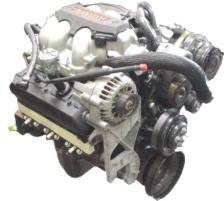
ASTRO INFO
|
HOW TO TELL DIFFERENCE BETWEEN "CPI & "CMFI" |
 |
From a service standpoint, however, this system has its weaknesses. There are two problems that have ended up being pattern failures. First, the system runs at higher fuel pressure than what we are accustomed to seeing, 56-64 psi. The poppet injectors will not open reliably with much less than 54 psi. I believe it was the Vortec cold hard start problem that was the inspiration for the concept of checking fuel pump rpm by means of the low current probe and the lab scope. The problem occurs during cold mornings when battery voltage is not what it might be. During cranking, voltage to the fuel pump drops. The rpm and consequently the pressure of the pump goes below the level necessary to open the poppet valves. Some of these hard starters took months to diagnose because a tow truck driver would hook up his jumper, and voltage would rise high enough to gain the extra two or three pounds of fuel pressure. Or, the vehicle would be towed in during the cold morning, but by the time the shop got around to checking the vehicle, the ambient temperature had warmed enough to kick up battery voltage, and the thing would start. Techs who were in the habit of not looking stuff up would see over 50 psi on their gauges, and, of course, that had to be enough! Sharp guys like Jeff Bach (current probe guru) and Jim Linder (the injector guru) learned how to scope the fuel pump waveform with the lab scope and calculate pump condition and rpm, almost to the point of being able to predict what day of the year the vehicle would fail to start!
The second common problem with the CPI system was the gradual failure of the fuel pressure regulator diaphragm. This could be a real pain to diagnose, as it had virtually no impact of fuel pressure. Rather, because the regulator is located inside the intake manifold, it would leak fuel and cause a rich condition under circumstances that seem to vary from vehicle to vehicle. Sometimes, when the failure is large, the engine will blow black smoke and perform very poorly. Other times, when the thing has just begun to leak, it will cause a lumpy, erratic, hunting idle condition as the computer tried to deal with the blobs of fuel coming from the leaky regulator.
The best way to diagnose these is the good old visual inspection. If the intake manifold runner control valve is removed, you can get a good look down inside the intake. A mirror is required on the vans, but it is generally possible to see the fuel washdown that occurs when the regulator starts to leak. Formerly, it was necessary to replace the entire spider-web assembly when the pressure regulator leaked, available from aftermarket sources as well as from GM. But Doug Garriott of LTS (Linder Technical Service -- Lindertech.com) tells me that they have shipped over 500 of their custom-engineered replacement fuel pressure regulators and have had very good success with them.
SCPI and the sticky poppet
Around 1996, GM "upgraded" CPI to SCPI. They look similar, but the SCPI unit has a fuel metering body with six or eight control valves in it. This retains the poppet valves at the end of nylon fuel pipes, very similar to those used on the CPI. This allows the PCM to fire these injectors sequentially for better performance and reduced emissions. The system works great until the poppet injectors stick, and a lot more than the the CPI system! The puzzling thing about this phenomenon is that only rarely did the CPI poppets stick. The most common customer complaint associated with the sticky poppet is a MIL. Codes set are almost always either a P0300 (random misfire) or a P0301-P0308, depending on the degree of the misfire of the cylinder involved. Often, when the vehicle gets to the shop there's no misfire, and the customer has typically not even felt a miss, Other times, one or more injectors will stick solidly, creating a dead miss.
--------------
[http://www.lindertech.com/newsletters/nwk2~04.pdf]
We have written many newsletter and magazine articles about the General Motors Central Sequential Fuel Injection (CSFI) system. You know the one; it's on the 1996 through 2001 4.3L/ 5.0L & 5.7L that suffers from stuck poppet valves. Many of you have tried to free the poppets as recommended by G. M. and clean these units. Or maybe you have even replaced the injector-poppet for the cylinder(s) that had the misfire. Then you find in a week or two the vehicle is back in your shop again for another misfire code.
You don't know what went wrong, it ran great when it left, but now you are back at square one again.
Well here's what happening, CSFI is similar to the CPI system used on previous 4.3L engines. Rather than one maxi style injector feeding all the poppets and firing
every crankshaft revolution, it uses one injector for each poppet that is fired sequentially. This gave the poppets a hot soak period before they fired again.
This made these units susceptible to tarnish build-up on the poppets and caused the poppets to stick. G. M. has even written lengthy tech bulletins about unsticking seized poppets and servicing this system but they still stick. So what is the answer? CALL LTS @ 888-809-3835
LTS now has NEW replacement units that utilizes a "mini-injector"
instead of a poppet valve. These units are a direct fit and very cost
effective. Get yours today and get that "come-back" out of your
shop!
-----------
www.lindertech.com/newsletters/nwk3~01.pdf
It has come to my attention that I have never dedicated a newsletter article to the
GM Central Sequential Fuel Injection system. We at LTS dedicated much time and
effort teaching and writing articles on the older 4.3L vortec system, that when this
new system came out, I think we all forgot that it needed to be discussed.
Central Sequential Fuel Injection is used on GM light trucks beginning as early as
1996. It is very similar to the CPI (Central Port Injection) system used on the
earlier 4.3L models. Rather than one TBI injector feeding all of the poppet nozzles,
there is now one electrical injector for each poppet nozzle. Each is fired
sequentially for accuracy and precise metering control.
The CSFI injectors are located in the fuel meter body assembly. Also included in
this assembly are the fuel inlet, return, fuel pressure regulator and electrical
connector for the injectors. Each injector and poppet nozzle assembly is a single
unit and can be service individually.
When an injector energizes, the increased fuel pressure pushes the poppet nozzle's
ball off its seat and fuel is supplied to the cylinder. When the injector de-energizes,
spring force overcomes the decreased fuel pressure and the ball seats, cutting off
fuel supply at the nozzle.
FUEL PRESSURE TESTING ON THE CSFI SYSTEM: With the key cycled "ON", the regulator should control the fuel pressure to the specification of 60-66 psi with
the pump running and the engine "OFF".
Fuel pressure that continues to fall after the engine has stopped or the ignition has been turned "OFF" could be
caused by:
· A leaky injector and poppet assembly · Damaged o-rings
· A leaking fuel pressure regulator valve · A partially disconnected fuel pulse damper (known as the pulsator) in the fuel tank.
COMMON FAILURES: *Internal contamination causes a rich condition (poppets are stuck open) OR damaged fuel tubes can cause a
lean condition.
*Rough idle after start-up when the vehicle has sat overnight…….. GM has issued a bulletin (87-65-07-A) ad-dressing
this problem. The problem affects 1996-1999 GM light trucks with 4.3L, 5.0L or 5.7L engines. This
condition is caused by deposit build-up on the ball-to-seat face and may cause a poppet to stick closed which
deprives that cylinder of fuel. It usually only affects one poppet at a time and it is not uncommon for the pop-pet
to free itself and resume normal operation. The bulletin describes the service methods needed when these
poppets stick closed and includes the use of a scan tool for fuel injector balance testing and a fuel pressure
gauge.
*Once the units have been replaced or have begun working properly, it is suggested that you add a 20-ounce
bottle of port fuel injection detergent to the fuel tank. (GM part# 12345104) According to Bulletin # 99-06-
04-006, the ONLY solvent that will have any effect on the deposits occurring on poppet nozzles is the GM ap-proved
detergent.
*Caution: These units have been known to leak fuel from the injector upper area into the harness, up through
the wiring and into the PCM/ VCM unit. The customer complaint is usually the smell of gasoline from the en-gine
compartment. Current GM warranty policy is 3 years/ 36,000 with an 8 year/ 80,000 mile warranty on the
PCM.
This problem was the focus of an e-mail discussion on iATN from Toby Jacobsen from Longview,
Washington. "Customer said he drove over to a friends house and when it came time to leave, the truck would
not start. Cranks over just fine. We started checking for spark…. no spark. Scanned for codes, had crank sen-sor,
tps, cam sensor, O2, too many codes! Had power to injector coil, but still no spark. Tested cam, crank,
tps and all were OK. Referred to Mitchell flow chart, did all the tests and found a bad PCM. Got the new
PCM from the dealer, and lo and behold, the bottom two PCM harness connectors were swollen and smelled
of gas. Traced the harness back to the injector housing assembly. Opened the old PCM and it had a shallow
amount of gas in it. Some how fuel migrated from the injector connector to the PCM."
-----------------
forums.vmag.com/ptsonoma/messages/820.html
...[2002 Astro, same problem] GM wants to blame on the gas, it's not the gas
we need a RECALL...Also with the CSFI systems, they require at least 55 psi to operate where as the older systems need as little as 10psi. Anything under 55psi will not start the vehicle...Try using Chevron w/techron to clean the poppets. If nothing improves, you might need to bring it to a mechanic for a professional cleaning. GM also sells a top-end cleaner and fuel system cleaner but they also recommed Chevron...
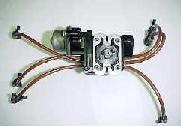 Vortec: CPI with single fuel injector. Used on 1995 4.3 Engine. A side view will show it doesn't have injectors for each fuel line. | 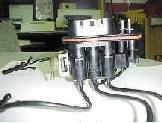 Note Fuel Injectors on each "pod." Differs from "CPI," which has only one Fuel Injector. |
You guys.... the truck is a 96 model year. Meaning it is an CSFI motor. Unfortunately the CSFI and CMPI (commonly called the CPI, meaning the one from 92-95) are both called the CPI by different companies. Its really a pain in the ass sometimes. your right Haynes and Chilton don't agree on what to call this injection system.
HOW
CPI Looks Like: a CPI engine looks like a spider sitting on the top of the engine and the intake tubes kinda wrap down onto the engine from the plenum and it just says VORTEC across the very top of the engine and its usually written in a NEON ORANGE color right in the middle of the intake plenum. [SEE PHOTO AT TOP 0F THIS ARTICLE - RJ]
ALSO: "CPI has an all aluminum intake than can be cut & welded.
CPI is OBD I ..." [The old style ALDL computer link - rj]
CSFI Looks Like: its got a black box where the air filter is sitting behind the driver's side headlight and it says VORTEC V6 on the top of the black box
-----------------------
[http://www.asashop.org/autoinc/may2001/fuel.htm ] With the loss of the throttle body units on its truck lines, General Motors used a new technology, the intake air fuel module (IAFM). The IAFM combined all the aspects of fuel management into a single intake manifold assembly. This system was called central port injection (CPI) on its 4.3L "W" engines.
It used a single injector to feed six poppet nozzles, one at each cylinder.
Unable to meet OBD II fuel control requirements, this system was replaced with central sequential fuel injection (CSFI) on all GM trucks in 1996.
This CSFI system came in either a six- or eight-injector fed poppet design, depending on engine application. The CSFI system provided misfire logic and better fuel control.
---------
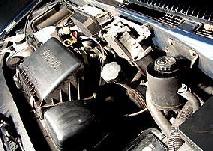 CSFI Astro - "Vortec" in center, on the air filter. |
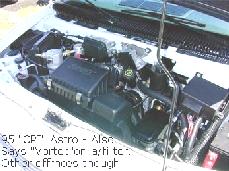 95 "CPI" Astro - Also says "Vortec" on air filter. Note other differences, though, in eng. compartment. |